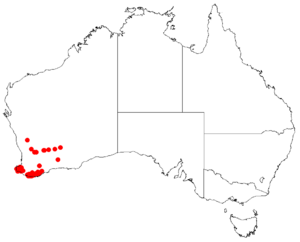Sickle hakea facts for kids
Quick facts for kids Sickle hakea |
|
|---|---|
| Scientific classification | |
| Genus: |
Hakea
|
| Species: |
falcata
|
 |
|
| Where the Sickle Hakea grows | |
The Hakea falcata, also known as the sickle hakea, is a special kind of shrub. It belongs to the Proteacea plant family. This plant is endemic to southern Western Australia. This means it naturally grows only in that part of the world. The sickle hakea has long, curved leaves. It also produces lovely cream-colored flowers. These flowers usually bloom in the spring season.
What Does It Look Like?
The sickle hakea is an upright shrub. It can grow to be about 2 to 4 meters (6.5 to 13 feet) tall. Its branches have light, rusty-brown hairs. The leaves are flat and curved. They are shaped a bit like an egg or a narrow oval. Each leaf is about 5 to 14 centimeters (2 to 5.5 inches) long. They are also 3 to 14 millimeters (0.1 to 0.5 inches) wide. These leaves have three or sometimes four lines running along them.
Flowers and Fruit
This plant blooms from September to November. It produces white-yellow or white-pink flowers. Each cluster of flowers has 25 to 40 individual blooms. The flowers have a creamy outer part. They also have a cream-colored pistil, which is the female part of the flower. This pistil is about 4.5 to 6.5 millimeters long.
After the flowers bloom, the plant grows a special fruit. This fruit is curved and has a distinct beak-like tip. It is about 2 to 2.5 centimeters (0.8 to 1 inch) long. The fruit is also 7 to 10 millimeters (0.3 to 0.4 inches) wide. Inside the fruit, you will find blackish-brown seeds. These seeds are narrow and oval-shaped. They have a wing on one side, which helps them spread.
How It Got Its Name
The sickle hakea was first officially described in 1830. A botanist named Robert Brown gave it its scientific name. The second part of its scientific name, falcata, comes from a Latin word. Falcatus means "curved like a sickle". This name was chosen because the plant's leaves are curved, just like a farmer's sickle tool.
Where Does It Grow?
The sickle hakea is found only in a specific area of Western Australia. It grows along the coast in the South West and Great Southern regions. You can find it between towns like Busselton and Albany. There is also a small group of these plants in the Stirling Range, near Cranbrook.
This shrub likes to grow in damp places. It is often found in areas that get wet in winter. It prefers peaty-sandy or sandy-clay soils. The sickle hakea often grows as a smaller plant under taller trees. It can be found in Jarrah forests or open Eucalypt woodlands.

